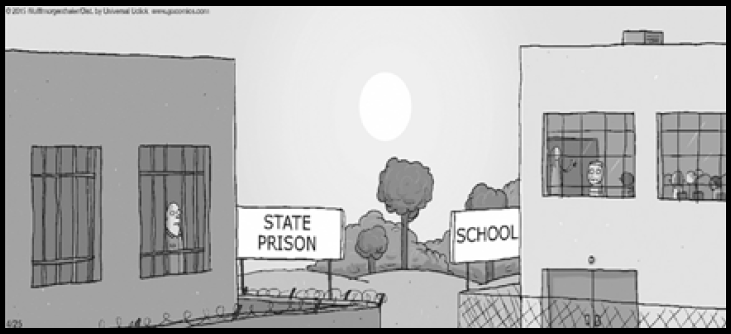DINOSAURS IN PRISONS
Drive by a medium-security prison. Take away the razor wire, add a mascot, and what do you have? A public school. They both contain people whose attendance is mandatory. Both are managed by a top- down hierarchy. When challenged by change, both generate more rules. There are some differences: You can’t be expelled from prison. Prisoners can’t pack a lunch. Children can’t appeal their sentence.
Schools and prisons look alike because they are alike. Nature, engineering, and architecture all follow the maxim that form follows function. So a bird’s wing and a plane’s wing have a lot in common. Purpose generates design. We pick up a sharp piece of flint and notice that it looks like a knife. Their shared purpose generates their congruent design. Dogs’ noses have flaps that channel their exhalation sideways. That way they don’t disturb what they’re sniffing. We don’t have those flaps (most of us, anyhow) because we don’t need those flaps. The basic shape of schools hasn’t evolved much because the basic principles of education haven’t. Their primary purpose has been, and still is, to control and correct.
House of correction is a euphemism for prisons. A medieval gaol (jail) on a hilltop in Turkey follows the same functional necessity as a county detention center in Maryland. Like turtles and tortoises, they are more alike than different. And that necessity limits the evolution of schools. The more schools focus on regulating learners, the more they resemble houses of correction. The evolution is clear: the newer the school, the fewer the windows, the wider the moat (parking lots), and the more ubiquitous the closed-circuit monitors. Security concerns, uniform standards, and diminished respect for teachers support a mechanistic approach to building schools and, more important, to what happens in them. So schools, bus schedules, and curricula are organized for efficiency, like factories. Or prisons. In 1940 there were 117,000 school districts in the United States. By 1990, that number had shrunk to 15,000. More efficient? Perhaps. Cost effective? Arguable. More creative? Hardly.
This theme of control and uniformity influences what’s taught as well. Test scores are principal in every public school as well as in most private schools. Test scores determine political support, real estate desirability, and funding. Test scores confine learning like a straitjacket, as though we graduate to a world of standardized tests and rote memorization. The focus on tests is merely a symptom of a greater blindness.







